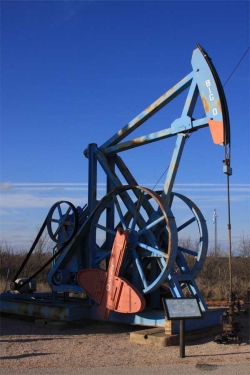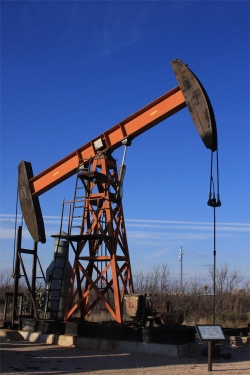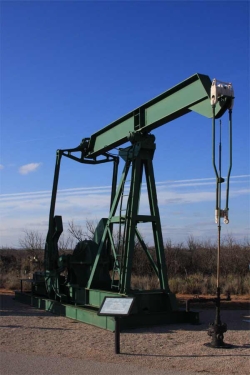|
Old Stuff from the Oil Fields
(The vanishing outdoor oil museum of the San Joaquin Valley)
 Pumping Jacks - Some oil wells flow on their own - a blowout is an extreme example of a flowing oil well - but for most wells a pump of some sort is required to bring the crude oil to the surface. The most common types of oil well pumps are pumping jacks, which are the "horse heads" everyone is familiar with bobbing up and down on the outskirts Bakersfield, Taft and Coalinga. The modern pump jack works on the same principle as the old wooden jacks of yesteryear, an example of which is the old pump jack on the left that used to stand off to the side of the junction of Midway Road and Highway 119 just outside of Taft (until Chevron tore in down in 2011).
Pumping Jacks - Some oil wells flow on their own - a blowout is an extreme example of a flowing oil well - but for most wells a pump of some sort is required to bring the crude oil to the surface. The most common types of oil well pumps are pumping jacks, which are the "horse heads" everyone is familiar with bobbing up and down on the outskirts Bakersfield, Taft and Coalinga. The modern pump jack works on the same principle as the old wooden jacks of yesteryear, an example of which is the old pump jack on the left that used to stand off to the side of the junction of Midway Road and Highway 119 just outside of Taft (until Chevron tore in down in 2011).
The upright wooden post on the pumpjack above is called the "Sampson Post" and the rocking arm that pivots on top of the post is the "walking beam". On the back end of the walking beam is a counter weight, which is sometimes just a wooden box filled with rocks. The counterweight on the Taft pump jack above is a square block of white concrete.
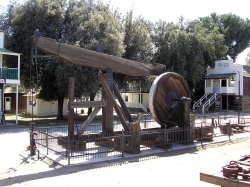 Connected to the front end of the walking beam are "polish rods", or "sucker rods", that run through the "casing head" down into the well hole. These rods connect to the actual pump that sits deep in the hole immersed in oil. You can see the sucker rods on the left side of this pump jack, which sits in front of the Fellows Hotel exhibit at the Kern County Museum. Connected to the front end of the walking beam are "polish rods", or "sucker rods", that run through the "casing head" down into the well hole. These rods connect to the actual pump that sits deep in the hole immersed in oil. You can see the sucker rods on the left side of this pump jack, which sits in front of the Fellows Hotel exhibit at the Kern County Museum.
When sucker rods push down on the pump, a valve on it opens up so that as the pump moves down oil can flows into the space above the valve. When the upstroke begins, the valve closes and oil sitting above the valve now is lifted upward. At the same time, oil from the reservoir moves into the void beneath the valve, and as the downstroke begins the valve opens back up so that the cycle can begins anew. Thus, oil is lifted to the surface, one upstroke at a time.
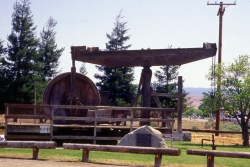 The big wooden wheels on those old pump jacks are "band wheels", which connect the pumpjack to an engine of one sort or another - steam in the old days, and oil or electric these days. A giant belt, in other words the "band", enables the engine to rotate the axis of the band wheel. A pivot arm called a "pitman" runs from the outer edge of the band wheel to the back end of the walking beam, and as the wheel rotates this pivot arm causes the beam to rock back and forth, thus moving the sucker rods up and down. The pitman is nicely silouetted on this old pump jack, which you can find on the north side of Coalinga as you head out of town on Highway 33. The big wooden wheels on those old pump jacks are "band wheels", which connect the pumpjack to an engine of one sort or another - steam in the old days, and oil or electric these days. A giant belt, in other words the "band", enables the engine to rotate the axis of the band wheel. A pivot arm called a "pitman" runs from the outer edge of the band wheel to the back end of the walking beam, and as the wheel rotates this pivot arm causes the beam to rock back and forth, thus moving the sucker rods up and down. The pitman is nicely silouetted on this old pump jack, which you can find on the north side of Coalinga as you head out of town on Highway 33.
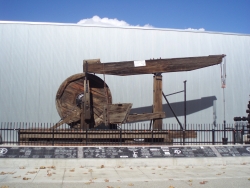 On the right is another of several pump jacks at the Kern County Museum. It sits on the side of the Black Gold Oil Exhibit at the museum, and it now has an iron railing around it. What is interesting about this pump jack is the wooden box filled with rocks on the right side of the band wheel. This box is a actually a counter weight, and all you need to do to balance the system is to add a few more rocks, or take some out. On the right is another of several pump jacks at the Kern County Museum. It sits on the side of the Black Gold Oil Exhibit at the museum, and it now has an iron railing around it. What is interesting about this pump jack is the wooden box filled with rocks on the right side of the band wheel. This box is a actually a counter weight, and all you need to do to balance the system is to add a few more rocks, or take some out.
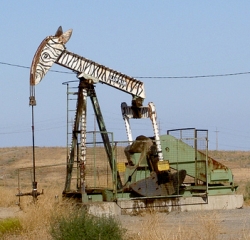 This pump jack is one of the denizens of Coalinga's 'Iron Zoo' - a menagerie of painted pump jacks visible from Highway 33 as it heads north out of town. We have a link with more information on the Iron Zoo of Coalinga that you can check out if you are interested. This pump jack is one of the denizens of Coalinga's 'Iron Zoo' - a menagerie of painted pump jacks visible from Highway 33 as it heads north out of town. We have a link with more information on the Iron Zoo of Coalinga that you can check out if you are interested.
|





